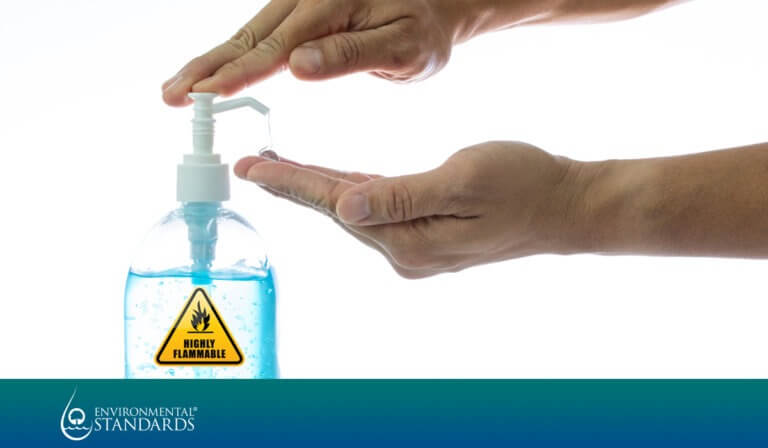
Unintended COVID Consequences – Potential Hazards and Compliance Obligations Associated with Hand Sanitizing
There have been many news stories expressing alarm over the number of disposable masks and gloves that are not actually being disposed. The stories usually highlight images of sidewalks and beaches littered with discarded masks and gloves. Hiding beneath these unintended COVID-19 consequences headlines are also stories of hand sanitizer injuries. In one example, an employee had applied hand sanitizer just before smoking a cigarette and caught their hand on fire as the sanitizer was not fully dried or wiped. The injury resulted in minor first degree (red skin) and second degree (blisters) burns, which required beyond first-aid treatment and was, therefore, an OSHA-recordable injury. A quick google search will yield many other similar stories, some of which are quite severe examples that resulted in hospitalization.
Hand fire hazards are not the only health and safety considerations associated with hand sanitizer use. These hand sanitizers are flammable materials which have environmental and health and safety (EHS) compliance obligations associated with their use, storage, and disposal.
Added to that, many companies are now purchasing much larger volumes of hand sanitizers than they have in the past. In some cases, facilities are purchasing sanitizer in 55-gallon drums and containers, which are then used to fill 1-gallon pump bottles. Because of the large demand on suppliers, some companies are forced to purchase from vendors with whom the company does not have a purchase history and which the company may not have thoroughly vetted.
Some examples of EHS compliance obligations associated with hand sanitizers are listed below.
Storage Incompatibilities:
Flammable liquids are incompatible with many types of other materials such as strong acids, peroxides, and halogens, and must be stored appropriately with adequate separation (for more storage incompatibilities see https://www.acs.org/content/acs/en/chemical-safety/basics/incompatible-chemicals.html).
Hygiene Concerns:
When companies purchase hand sanitizers from new suppliers that have not been properly vetted, they could face purity issues in the purchased material. Impurities identified in hand sanitizer include methanol and benzene, among other potentially poisonous impurities. As such, employees should consider additional hand washing prior to eating, drinking, and smoking, if using hand sanitzers from an unvetted supplier (see the Food and Drug Administration’s (FDA’s) warnings on unsafe hand sanitizers: https://www.fda.gov/drugs/drug-safety-and-availability/fda-advises-consumers-not-use-hand-sanitizer-products-manufactured-eskbiochem).
Hazardous Waste Management:
As hand sanitizer is flammable waste, hand sanitizer waste would also be considered a characteristic hazardous waste (unless tested to be otherwise). As such, the Resource Conservation and Recovery Act (RCRA) empty-container rule comes into play. Likewise, wipes and rags utilized to apply hand sanitizer and disposed would also be subject to hazardous waste determination and ultimately to the excluded solvent-contaminated wipes rule, if available in your state, https://www.epa.gov/hwgenerators/where-solvent-contaminated-wipes-final-rule-effect.
When purchasing and using hand sanitizer at your site, ensure you can answer these questions:
- Are you buying hand sanitizer in bulk? If so, have you evaluated potential hazards associated with bulk storage and transportation?
- Has the hand sanitizer been added to your hazard communication program (e., safety data sheets (SDS) and communication of hazards associated with use)?
- Are you purchasing hand sanitizer from reputable and trusted suppliers, and does the product you purchased include other toxics?
- Do your employees know to only dispose of “empty” containers of hand sanitizer?
- Do you have a process for disposal of unused or expired hand sanitizer?
- If you are using application wipes, are you managing these wipes in accord with the excluded solvent-contaminated wipes rule?
Please contact Shaun Gilday or Cody Dye to support identification of hazards and compliance obligations associated with and sanitizers, and other chemicals, as well.

